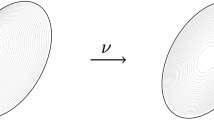Abstract
We derive a \(L^1_x (\mathbb {R}^d)-L^{\infty }_x (\mathbb {R}^d)\) decay estimate of order \(\mathcal O \left( t^{-d/2}\right) \) for the linear propagators
with a loss of 3d/4 or d/4–derivatives in the case \(\beta =0\) or \(\beta =1\), respectively. These linear propagators are known to be associated with the linearized water wave equations, where the parameter \(\beta \) measures surface tension effects. As an application, we prove low regularity well-posedness for a Whitham–Boussinesq-type system in \(\mathbb {R}^d\), \(d\ge 2\). This generalizes a recent result by Dinvay, Selberg and the third author where they proved low regularity well-posedness in \(\mathbb {R}\) and \(\mathbb {R}^2\).
Similar content being viewed by others
Notes
Here we used the notation \(a \pm : =a \pm \varepsilon \) for sufficiently small \(\varepsilon >0\).
References
Carter, J.D.: Bi-directional Whitham equations as models of waves on shallow water. Wave Motion 82, 51–61 (2018)
Deneke, T., Dufera, T.T., Tesfahun, A.: Comparison between Boussinesq and Whitham-Boussinesq type systems. Math. Methods Appl. Sci. (2022). https://doi.org/10.1002/mma.8304
Dinvay, E.: On well-posedness of a dispersive system of the Whitham-Boussinesq type. Appl. Math. Lett. 88, 13–20 (2019)
Dinvay, E., Dutykh, D., Kalisch, H.: A comparative study of bi-directional Whitham systems. Appl. Numer. Math. 141, 248–262 (2019)
Dinvay, E., Moldabayev, D., Dutykh, D., Kalisch, H.: The Whitham equation with surface tension. Nonlinear Dyn. 88, 1125–1138 (2017)
Dinvay, E., Selberg, S., Tesfahun, A.: Well-posedness for a dispersive system of the Whitham-Boussinesq type. SIAM J. Math. Anal. 52(3), 2353–2382
Grafakos, L.: Classical Fourier analysis, third ed., Graduate Texts in Mathematics, vol. 249, Springer, New York (2014)
John, F.: Plane Waves and Spherical Means Applied to Partial Differential Equations. Springer, Berlin (1981)
Klein, C., Linares, F., Pilod, D., Saut, J.-C.: On Whitham and related equations. Stud. Appl. Math. 140, 133–177 (2018)
Lannes, D.: Water waves: Mathematical Theory and Asymptotics, Mathematical Surveys and Monographs, vol. 188. AMS, Providence (2013)
Pilod, D., Saut, J.-C., Selberg, S., Tesfahun, A.: Dispersive estimates for full dispersion KP equations. J. Math. Fluid Mech. 23, 25 (2021). https://doi.org/10.1007/s00021-021-00557-3
Remonato, F., Kalisch, H.: Numerical bifurcation for the capillary Whitham equation. Physica D 343, 51–62 (2017)
Stein, E.M.: Harmonic Analysis: Real-Variable Methods, Orthogonality, and Oscillatory Integrals, Princeton Mathematical Series, vol. 43. Princeton University Press, Princeton, NJ (1993)
Tesfahun, A.: Long-time existence for Whitham-Boussinesq system in two dimensions. Commun. Contemp. Math. (2022). https://doi.org/10.1142/S0219199722500651
Tao, T.: Nonlinear Dispersive Equations, CBMS Reg. Conf. Ser. Math. 106, AMS, Providence, RI (2006)
Acknowledgements
The authors would like to thank the anonymous referees for useful comments on an earlier versions of this article. A. Tesfahun was supported by the Faculty Development Competitive Research Grants Program 2022-2024, Nazarbayev University: Nonlinear Partial Differential Equations in Material Science (Ref. 11022021FD2929)
Author information
Authors and Affiliations
Corresponding author
Additional information
Communicated by Nader Masmoudi.
Publisher's Note
Springer Nature remains neutral with regard to jurisdictional claims in published maps and institutional affiliations.
Appendix
Appendix
In this appendix, we derive some useful estimates on the derivatives of all order for the function
Estimates for the first- and second-order derivatives of this function are derived recently in [11].
Clearly,
Lemma 5
Let \(\beta \in \{0, 1\}\) and \(r>0\). Then,
Moreover,
Proof
The estimates (6.2) and (6.3) are proved in [11, Lemma 3.2, see its proof in Section 5]. So we only prove (6.4).
Let
Then,
In general, we have
for some polynomial \(P_{j-1}\) of degree \(j-1\).
Clearly,
So \( |P_{j-1}( S, T) |\lesssim 1\), and hence
Write
where \(f_\beta (r)= \sqrt{ r} \langle \sqrt{\beta } r \rangle \) and \( T_0(r)=\sqrt{ T(r) }.\) One can show that
Combining (6.5) with \(T(r) \sim r\langle r \rangle ^{-1} \) we obtain
Finally, we use (6.6) and (6.7) to obtain for all \(k \ge 3\),
\(\square \)
Corollary 2
For \(\lambda , r>0\), define \(m_{\beta , \lambda }(r)= m_\beta (\lambda r)\). Then,
Proof
Observe that
By (6.2) we have, for \(r\sim 1\),
Finally, one can combine these two estimates with the differentiation formula
to obtain the desired estimate (6.8). \(\square \)
Rights and permissions
Springer Nature or its licensor (e.g. a society or other partner) holds exclusive rights to this article under a publishing agreement with the author(s) or other rightsholder(s); author self-archiving of the accepted manuscript version of this article is solely governed by the terms of such publishing agreement and applicable law.
About this article
Cite this article
Deneke, T., Dufera, T.T. & Tesfahun, A. Dispersive Estimates for Linearized Water Wave-Type Equations in \(\mathbb {R}^d\). Ann. Henri Poincaré 24, 3741–3761 (2023). https://doi.org/10.1007/s00023-023-01322-0
Received:
Accepted:
Published:
Issue Date:
DOI: https://doi.org/10.1007/s00023-023-01322-0



